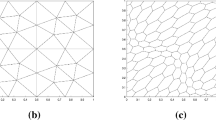Abstract
We propose a continuous interior penalty finite element method designed for a third-order singularly perturbed problem. Using higher order polynomials on Shishkin-type layer-adapted meshes, a robust convergence has been proved in the corresponding energy norm. Moreover, we show numerical experiments which support our theoretical findings.
Similar content being viewed by others
References
Brenner SC, Sung L-J (2005) \(C^0\) interior penalty methods for fourth order elliptic boundary value problems on polygonal domains. J Sci Comput 22(23):83–118
Ern A, Guermond J-L (2004) Theory and practice of finite elements. Springer, New York
Franz S, Roos H-G, Wachtel A (2014) A \(C^0\) interior penalty method for a singularly-perturbed fourth-order elliptic problem on a layer-adapted mesh. Numer Methods Partial Differ Equ 30(3):838–861
Gartland EC (1988) Graded-mesh difference schemes for singularly perturbed two-point boundary value problems. Math Comput 51:631–657
Howes FA (1983) The asymptotic solution of a class of third-order boundary value problems arising in the theory of thin film flows. SIAM J Appl Math 43(5):993–1004
Howes FA (1984) Asymptotic structures in nonlinear dissipative and dispersive systems. Phys D Nonlinear Phenom 12(1–3):382–390
Linss T (2001) The necessity of Shishkin decompositions. Appl Math Lett 14:891–896
Linss T (2010) Layer-adapted meshes for reaction-convection-diffusion problems. Springer, Heidelberg
O’Malley RE (1974) Introduction to singular perturbations. Academic Press, New York
Roos H-G (2012) Robust numerical methods for singularly perturbed differential equations: a survey covering 2008–2012. ISRN Appl Math 2012:Article ID 379547. doi:10.5402/2012/379547
Roos H-G, Stynes M, Tobiska L (2008) Robust numerical methods for singularly perturbed differential equations. Springer, Berlin
Roos H-G, Teofanov Lj, Uzelac Z (2015a) Graded meshes for higher order FEM. J Comput Math 33(1):1–16
Roos H-G, Teofanov Lj, Uzelac Z (2015b) Uniformly convergent difference schemes for a third order singularly perturbed boundary value problem. Appl Numer Math 96:108–117
Roos H-G, Linss T (1999) Sufficient conditions for uniform convergence on layer-adapted grids. Computing 63:27–45
Steinbach O (2008) Numerical approximation methods for elliptic boundary value problems. Springer, New York
Author information
Authors and Affiliations
Corresponding author
Additional information
Communicated by Jose Alberto Cuminato.
The work of H. Zarin and the Lj. Teofanov was supported by the Ministry of Education, Science and Technological Development of the Republic of Serbia under Grant 174030.
Appendices
Appendices
1.1 Appendix 1: Proof of existence of weak solutions
First we verify the inf-sup condition
To do that we estimate \(|v|_{H^1(\Omega )}\) and \(\varepsilon |v|_{H^2(\Omega )}\) separately. We get easily
and therefore
For estimating \(\varepsilon |v|_{H^2(\Omega )}\) we use the possibility to estimate the \(L^2\)-norm by the sum of the \(H^{-1}\)-norm and the \(H^{-1}\)-norm of the derivative, see Steinbach (2008, Theorem 2.17). It follows
Now
Moreover,
Taking into account
we get
Consequently, we have proved (48).
Finally we consider the equation
Taking \(v\in C_0^\infty (\Omega )\), from
we conclude that w belongs to the space \(H^2(\Omega )\). Moreover, it satisfies the homogenous adjoint problem
with the additional boundary condition \(w'(0)=0\). Setting \(w=v\) in (49), we get
thus \(w=0\).
Now, the unique solvability of the Galerkin formulation (5)–(6) follows and moreover, stability with respect to the norm in X.
1.2 Appendix 2: Proof of Lemma 2
On an interval \(I_i\subset \Omega _f\), \(i=N/2+1,\ldots ,N\), starting from the standard interpolation estimate (23) and (4), we first have
From (21) and the properties of the mesh-generating and mesh-characterizing functions, we get
in order to derive
Applying the last inequality into (50) gives us
Here we have used (21) as well as
Now taking sum over all intervals from the fine part of the mesh we get
due to
Thus, we have proved (28).
Using similar arguments we derive
since
Hence, the inequality (29) is also proven.
Rights and permissions
About this article
Cite this article
Zarin, H., Roos, HG. & Teofanov, L. A continuous interior penalty finite element method for a third-order singularly perturbed boundary value problem. Comp. Appl. Math. 37, 175–190 (2018). https://doi.org/10.1007/s40314-016-0339-3
Received:
Revised:
Accepted:
Published:
Issue Date:
DOI: https://doi.org/10.1007/s40314-016-0339-3
Keywords
- Singularly perturbed differential equation
- Third-order boundary value problem
- Interior penalty finite element method
- Layer-adapted mesh




